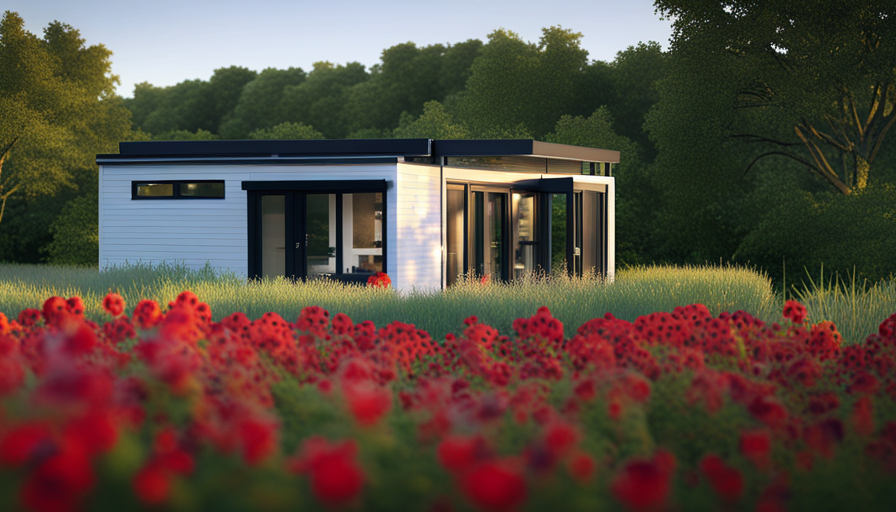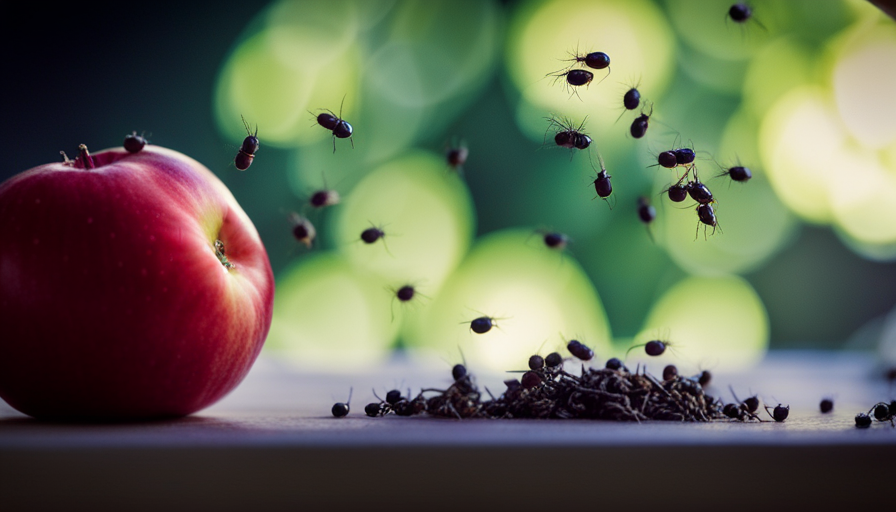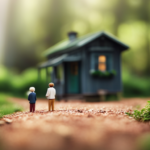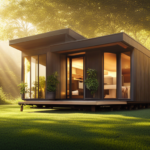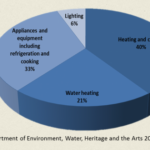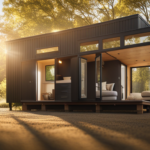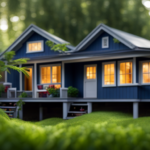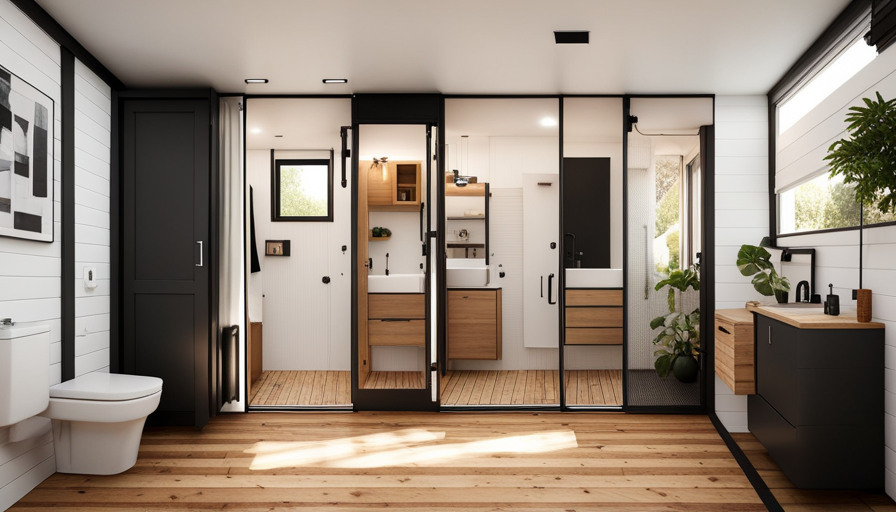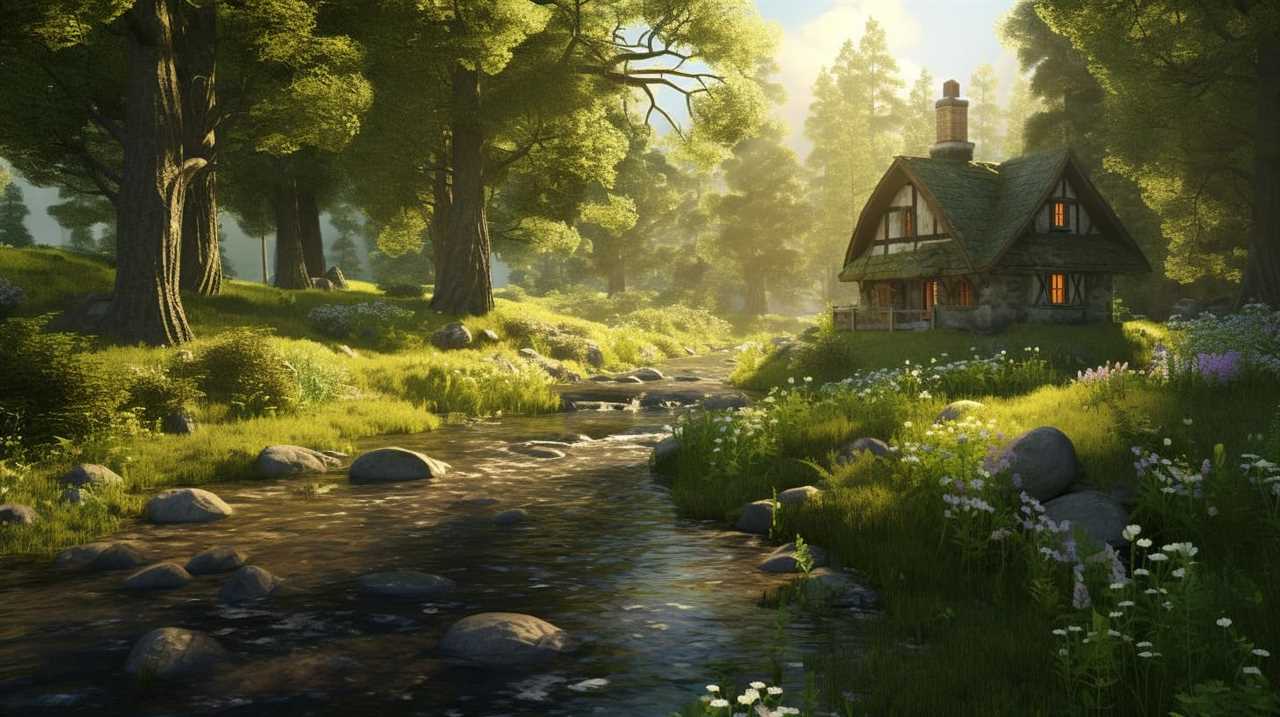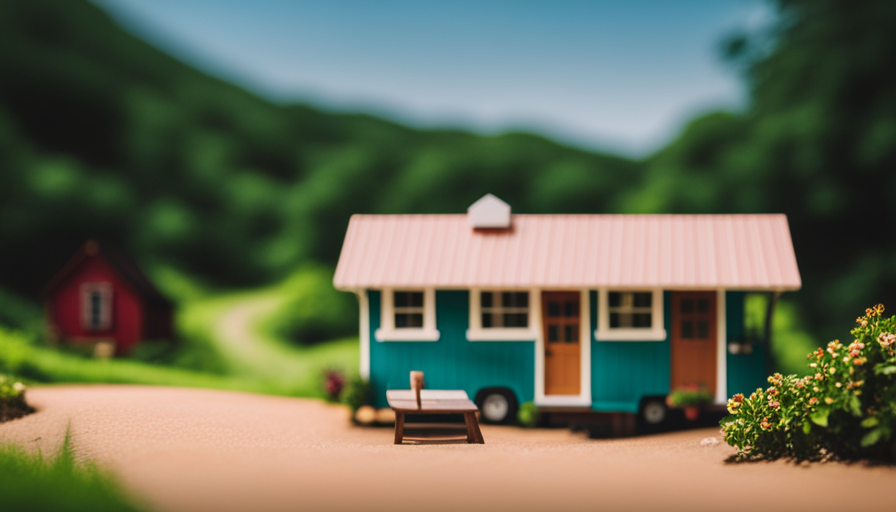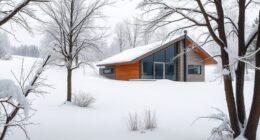Did you know that the average cost of a tiny house in the United States is around $25,000? This is less than a quarter of the price of a traditional-sized home! If the idea of living in a tiny house interests you, particularly for financial reasons, then this is the ideal place for you.
In this article, I will delve into the various factors that influence the cost of a tiny house, helping you understand what to expect when it comes to budgeting for your own miniature abode. We will explore the different types of tiny houses available, the construction materials used, the design features that can impact the price, and even the location and utilities considerations.
Additionally, we will discuss the costs associated with maintenance, furniture, appliances, and any other expenses you might encounter along the way. So, if you’re curious about how much a tiny house really costs, let’s dive in and uncover the truth together.
Key Takeaways
- The average cost of a tiny house in the United States is $25,000, which is less than a quarter of the price of a traditional house.
- Factors influencing the cost of a tiny house include construction methods, interior design, construction materials, energy-efficient features, personalization options, location, zoning restrictions, and legal requirements.
- Financing options such as personal loans, RV loans, and construction loans are available for tiny houses, and insurance coverage is necessary for a tiny house.
- Additional costs for a tiny house include permits, utility connections, land, ongoing repairs and upkeep, customization, and hidden expenses, so careful planning, budgeting, and tracking of expenses are important for an affordable project.
Types of Tiny Houses
Are you ready to discover the incredible variety of tiny houses out there? When it comes to types of tiny houses, the options are truly endless. From traditional cottages to modern minimalist designs, there is a tiny house to suit every taste and lifestyle.
One important aspect to consider when choosing a tiny house is the construction method. Some tiny houses are built using traditional construction methods, while others utilize innovative techniques such as prefabrication or modular construction. These methods can have an impact on both the cost and the time it takes to build the house.
Another key factor to consider is the interior design of the tiny house. While the size may be small, the design possibilities are vast. Some tiny houses feature clever space-saving solutions like built-in furniture and multi-functional rooms. Others prioritize a more open and airy feel, with large windows and minimalist decor. The interior design of a tiny house can greatly impact its functionality and overall aesthetic.
Now that we’ve explored the different types of tiny houses and their construction methods and interior design, let’s move on to the next section: construction materials.
Construction Materials
You can use affordable and sustainable materials to create a cozy and efficient living space. When it comes to constructing a tiny house, there are various construction techniques and cost-saving measures that can be employed.
One popular method is using reclaimed or recycled materials. Not only does this help reduce the cost of materials, but it also promotes sustainability by repurposing items that would otherwise end up in a landfill.
Another cost-saving measure is opting for lightweight materials. By using materials such as lightweight steel or engineered wood, you can minimize the overall weight of the tiny house, which can lead to savings in transportation and foundation costs.
Additionally, incorporating energy-efficient features can save money in the long run. Insulation, for example, can help reduce heating and cooling expenses. Installing energy-efficient windows and appliances can also contribute to lower utility bills.
By employing various construction techniques and cost-saving measures, it is possible to build a tiny house using affordable and sustainable materials. These choices not only have financial benefits but also contribute to a greener lifestyle.
Transitioning into the subsequent section about ‘design features,’ it is essential to consider how these materials and techniques can be combined with innovative design features.
Design Features
When it comes to designing a tiny house, there are several key points to consider.
First, exploring customizable options allows for a personalized touch and ensures that the space meets your specific needs and preferences.
Second, considering energy efficiency features can help reduce your environmental impact and save on utility costs.
Lastly, incorporating sustainability features not only promotes a greener lifestyle but also contributes to the overall longevity and durability of the tiny house.
Explore Customizable Options
Customizable options for tiny houses offer endless possibilities, allowing homeowners to create their dream space that reflects their unique personality and style, making the emotional investment even more meaningful.
When it comes to customizable designs, homeowners can choose from a variety of layouts, finishes, and materials to create a space that suits their needs and preferences. Additionally, there are cost-saving options available that can help keep the overall cost of the tiny house down. For example, using reclaimed or recycled materials for construction or opting for energy-efficient appliances and fixtures can not only reduce the environmental impact but also save money in the long run.
It’s important to consider these customizable options and cost-saving measures when designing a tiny house to ensure a beautiful and efficient living space that meets both personal and financial goals.
When considering energy efficiency and sustainability features, homeowners can further enhance the functionality and eco-friendliness of their tiny house.
Consider Energy Efficiency and Sustainability Features
Enhance your tiny house experience by incorporating energy-efficient and sustainable features that will not only save you money but also contribute to a greener lifestyle. By investing in energy-efficient appliances and systems, you can significantly reduce your energy consumption and lower your utility bills. Consider installing solar panels to harness renewable energy and reduce your reliance on the grid.
Additionally, choosing sustainable materials for construction, such as reclaimed wood or recycled metal, can minimize the environmental impact of your tiny house. Incorporating proper insulation and efficient heating and cooling systems will ensure optimal comfort while reducing energy waste.
Lastly, implementing water-saving fixtures and rainwater harvesting systems will help conserve water resources. By prioritizing energy efficiency and sustainable materials, you can create a more eco-friendly and cost-effective tiny house.
Transitioning to the next section, the location of your tiny house also plays a crucial role in its overall cost and convenience.
Location
When it comes to the cost of a tiny house, one important factor to consider is the location. The costs of different locations can vary significantly, impacting the overall price of the house.
Additionally, it’s important to consider zoning and legal requirements in different areas, as they can also affect the cost and feasibility of building a tiny house.
By comparing costs of different locations and being aware of zoning and legal requirements, I can make a more informed decision about where to build my tiny house.
Compare Costs of Different Locations
Looking to save money on a tiny house? Let’s explore how much it’ll cost you in different locations.
Here’s a location comparison to help you compare costs:
-
Rural areas: Building a tiny house in a rural area can be more affordable due to lower land prices and less strict zoning regulations.
-
Suburbs: While suburban areas offer more amenities and convenience, the cost of land and permits may be higher, increasing the overall expenses.
-
Urban areas: Tiny houses in urban areas come with a higher price tag due to expensive land prices and stricter building codes.
-
Off-grid locations: Building an off-grid tiny house can be cost-effective in the long run, as you won’t have to rely on utility bills.
Consider zoning and legal requirements when choosing a location for your tiny house. These factors will play a crucial role in determining the overall cost and feasibility of your project.
Consider Zoning and Legal Requirements
When comparing costs of different locations for tiny houses, it’s crucial to also consider zoning and legal requirements.
Zoning restrictions vary from one area to another, and they can greatly impact the feasibility and cost of building a tiny house. Some areas have specific zoning regulations that limit the size and use of tiny houses, while others may have more flexible regulations or even designated tiny house communities.
Additionally, obtaining the necessary building permits is essential and can add to the overall cost of constructing a tiny house. It’s important to research and understand the zoning restrictions and building permit requirements in the desired location before proceeding with any plans.
By taking these factors into account, it’s possible to make an informed decision about the cost and feasibility of building a tiny house.
Moving on to the next section, let’s explore the options for utilities and off-grid capabilities.
Utilities and Off-grid Options
There are various off-grid options and utilities available for a tiny house, making it more cost-effective and environmentally friendly. When it comes to off-grid living, a tiny house offers a range of possibilities. Here are five options to consider:
-
Solar Power: Installing solar panels on the roof can provide electricity to the tiny house. This sustainable energy source can power lights, appliances, and other electronic devices.
-
Rainwater Collection: Capturing and storing rainwater can provide a sustainable and cost-effective source of water for daily needs such as showering, cooking, and cleaning.
-
Composting Toilets: These toilets do not require a connection to a sewer system, making them ideal for off-grid living. They convert waste into compost that can be used for gardening.
-
Graywater Systems: These systems collect and filter wastewater from sinks, showers, and laundry machines. The treated water can then be reused for irrigation or flushing toilets.
-
Propane Gas: Many tiny houses use propane for heating, cooking, and even powering refrigerators. Propane is a versatile and efficient fuel option for off-grid living.
Considering these off-grid options and utilities can help minimize costs and reduce environmental impact. As we transition into the subsequent section about financing and insurance, it’s important to understand the financial implications of these sustainable choices.
Financing and Insurance
When it comes to financing a tiny house, it’s important to research all available options. This includes looking into traditional mortgages, personal loans, or even crowdfunding.
Additionally, understanding the insurance requirements and costs associated with owning a tiny house is crucial in order to protect your investment.
By taking the time to thoroughly research financing and insurance options, you can ensure a smooth and secure transition into tiny house living.
Research Financing Options for Tiny Houses
One popular option for financing a tiny house is to explore different lending options. There are several financing options available for those looking to purchase a tiny house, including personal loans, RV loans, and construction loans. Personal loans are a common choice, as they can be used for various purposes and have flexible repayment terms. RV loans are specifically designed for recreational vehicles, such as tiny houses on wheels, and often offer competitive interest rates. Construction loans are ideal for those building their own tiny house and can provide funds throughout the construction process. To help you compare these options, here is a table outlining some key features of each type of loan:
| Financing Option | Key Features |
|---|---|
| Personal Loan | Flexible use, varying interest rates and terms |
| RV Loan | Specifically for tiny houses on wheels, competitive interest rates |
| Construction Loan | Ideal for building your own tiny house, funds provided throughout the construction process |
Understanding insurance requirements and costs is also an important aspect of financing a tiny house.
Understand Insurance Requirements and Costs
Securing insurance for your tiny home can provide peace of mind and protect your investment in case of unforeseen events. When it comes to insuring a tiny house, there are certain requirements you need to meet.
Most insurance companies will require you to have a permanent foundation for your tiny house, as well as meeting building codes and safety standards. Additionally, they may also require you to have certain safety features such as smoke detectors and fire extinguishers.
The insurance cost for a tiny house can vary depending on several factors, including the size, location, and value of your home. It’s important to shop around and compare quotes from different insurance providers to find the best coverage at the most affordable price.
Understanding the insurance requirements and costs will help you make an informed decision when insuring your tiny house.
Moving on to the next section about ‘maintenance and upkeep,’ it’s crucial to keep your tiny house in good condition to ensure its longevity and value.
Maintenance and Upkeep
To keep your tiny house in tip-top shape, you’ll need to regularly maintain and upkeep it. Here are four key aspects to consider when it comes to maintaining your tiny house:
-
Regular Cleaning: Just like any home, your tiny house will require regular cleaning. From dusting and sweeping to vacuuming and mopping, keeping your home clean will not only make it more pleasant to live in but also help prevent any potential damage caused by dirt and grime buildup.
-
Exterior Maintenance: Tiny houses often have unique exteriors, such as cedar siding or metal cladding. Regularly inspecting and maintaining the exterior will help protect it from weather damage and extend its lifespan. This may include repainting, sealing, or repairing any cracks or damages.
-
Plumbing and Electrical Checks: Tiny houses have limited space, so it’s essential to ensure that the plumbing and electrical systems are in good working order. Regularly inspecting these systems and addressing any issues promptly will help avoid costly repairs in the long run.
-
Roof and Insulation: Your tiny house’s roof and insulation play a crucial role in maintaining a comfortable living environment. Regularly inspect the roof for any leaks or damage, and make sure the insulation is intact and functioning properly.
With proper maintenance, you can ensure that your tiny house stays in great condition for years to come. Moving on to the next section about ‘furniture and appliances,’ it’s important to consider how to furnish your tiny house efficiently.
Furniture and Appliances
When it comes to furnishing a tiny house, it’s important to consider the budget for essential furniture and appliances.
Since space is limited, it’s crucial to choose items that are not only functional but also space-saving.
Exploring options that are multi-functional can also help maximize the limited space available.
Budget for Essential Furniture and Appliances
Ironically, splurging on extravagant furniture and appliances isn’t within the budget for a tiny house. When budgeting for a tiny kitchen, it’s important to prioritize functionality and space efficiency. Opt for cost-effective furniture options to maximize the limited space available. Look for compact dining tables and chairs that can be folded or stacked when not in use. Consider wall-mounted shelves and cabinets to optimize vertical space. Additionally, invest in multi-functional appliances, such as a combination washer-dryer or a compact stove with built-in storage, to save both space and money. By carefully selecting furniture and appliances that are both budget-friendly and space-saving, you can make the most of your tiny house living experience.
Now, let’s explore space-saving and multi-functional options for other areas of the house.
Explore Space-saving and Multi-functional Options
Maximize your living space by exploring space-saving and multi-functional options for every area of your tiny home. In a small space, it’s crucial to make the most of every inch. Look for furniture and appliances that serve multiple purposes, such as a sofa that can be converted into a bed or a dining table that can be folded down when not in use.
Consider investing in storage solutions that utilize vertical space, like wall-mounted shelves or hanging organizers. Opt for compact appliances that are designed specifically for small spaces, such as a combination washer and dryer or a dishwasher drawer. By choosing these space-saving solutions and multi-functional furniture, you can create a comfortable and functional living area in your tiny home.
Transitioning into the subsequent section about additional costs, it’s important to consider the expenses that come with customizing your tiny house.
Additional Costs
To get a better idea of the additional costs involved, you can expect to spend around $5,000 to $10,000 on permits and utility connections alone. These costs can vary depending on the location and the specific requirements of your tiny house.
In addition to these upfront expenses, there are a few other hidden expenses that you should consider when budgeting for your tiny house:
-
Land: Finding a suitable piece of land to park your tiny house can be an additional cost. Whether you decide to rent a space in a tiny house community or purchase your own land, it’s important to factor in this expense.
-
Insurance: Just like any other dwelling, your tiny house may require insurance coverage. It’s important to research and compare different insurance options to find the best coverage for your needs.
-
Maintenance: While tiny houses are generally low-maintenance, there will still be ongoing costs for repairs and upkeep. It’s a good idea to set aside some funds for routine maintenance to keep your tiny house in good condition.
-
Customization: If you want to personalize your tiny house with unique features or custom-built furniture, this may incur additional costs. Consider your budget for any customization you may desire.
Overall, it’s essential to carefully consider all the additional costs and hidden expenses involved in owning a tiny house. By factoring in these expenses, you can create a realistic budget and ensure that you’re financially prepared for your tiny house journey.
Overall Budgeting and Cost Considerations
Planning your budget for a tiny house adventure involves considering various factors and expenses. It is important to carefully plan and budget in order to ensure a successful and affordable project. When it comes to budgeting considerations for a tiny house, there are several key factors to keep in mind.
First and foremost, you need to determine your overall budget for the project. This includes not only the cost of the tiny house itself, but also any additional expenses such as land, permits, and utilities. It is important to be realistic about what you can afford and to factor in any unexpected costs that may arise.
One helpful tool for budgeting is creating a detailed breakdown of all the expenses involved. This can be done using a table that outlines the various costs and allows you to track your spending. Here is an example:
| Expense | Estimated Cost |
|---|---|
| Tiny House | $40,000 |
| Land | $20,000 |
| Permits | $2,000 |
| Utilities | $1,500 |
| Miscellaneous | $5,000 |
Another important consideration when budgeting for a tiny house is to explore cost-saving strategies. This could include building the tiny house yourself or using salvaged materials to reduce expenses. Additionally, you could consider alternative energy sources to lower utility costs in the long run.
By carefully considering your budgeting considerations and implementing cost-saving strategies, you can make your tiny house adventure more affordable and enjoyable. Remember to be realistic about your budget and to track your expenses to stay on track.
Frequently Asked Questions
Are tiny houses legal in all states?
Tiny house regulations and zoning restrictions vary across states. While some states have embraced the tiny house movement, others have stricter regulations. It’s essential to research and understand the specific rules in your state before building or purchasing a tiny house.
How long does it typically take to build a tiny house?
Typically, building a tiny house takes around 3-6 months, depending on various factors such as size, complexity, and available resources. Cost estimation can vary greatly depending on materials, design, and location.
Can I customize the design of my tiny house?
Yes, you can customize the design of your tiny house. There are various customization options available, such as layout, materials, and finishes. When considering design, factors like space optimization and functionality are important for tiny houses.
Are there any restrictions on where I can park or place my tiny house?
There are various Tiny house parking regulations and zoning restrictions that dictate where you can park or place your tiny house. These regulations vary depending on the location and may include minimum size requirements, permits, and specific zoning designations.
What are the most common challenges people face when living in a tiny house?
Living in a tiny house presents challenges like limited storage and maintenance. Maximizing space is crucial, but it requires constant organization and creative solutions. Despite the obstacles, the benefits of minimalism and financial freedom make it worthwhile.
Conclusion
In conclusion, the cost of a tiny house varies depending on several factors such as size, materials used, design features, location, and utilities. However, one interesting statistic that evokes emotion is that the average cost of a tiny house in the United States is around $65,000.
This figure highlights the affordability and accessibility of tiny homes, making them a viable option for those looking to downsize or live a more sustainable lifestyle. With proper budgeting and careful consideration of additional costs, owning a tiny house can be a practical and fulfilling choice.
Hi, I’m Emma. I’m the Editor in Chief of Tiny House 43, a blog all about tiny houses. While tree houses are often associated with childhood, they can be the perfect adult retreat. They offer a cozy space to relax and unwind, surrounded by nature. And since they’re typically built on stilts or raised platforms, they offer stunning views that traditional homes simply can’t match. If you’re looking for a unique and romantic getaway, a tree house tiny house might just be the perfect option.
